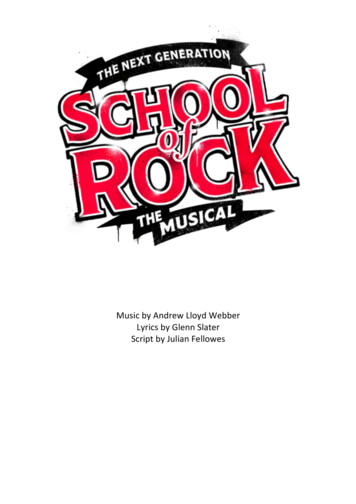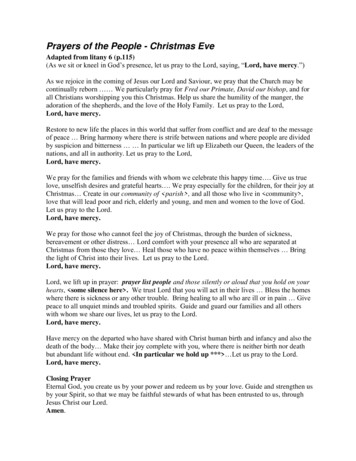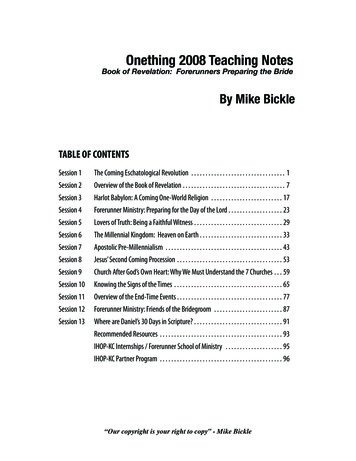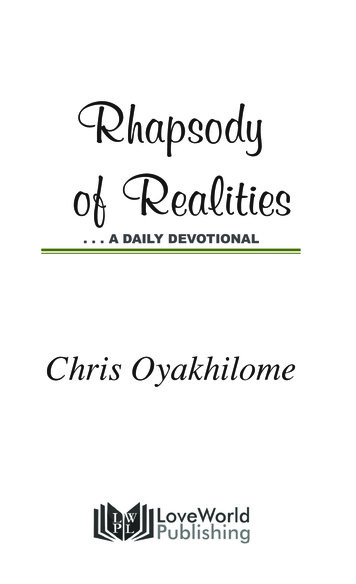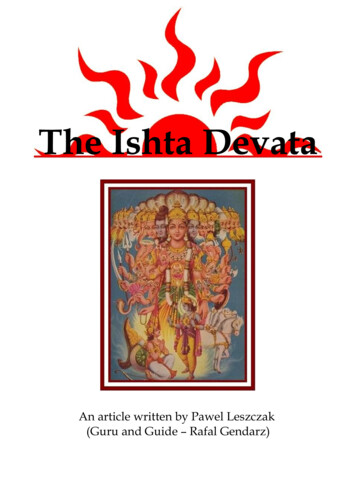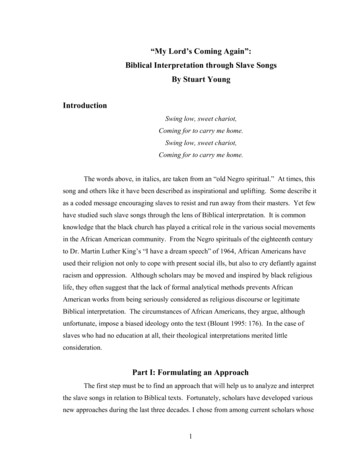
Transcription
“My Lord’s Coming Again”:Biblical Interpretation through Slave SongsBy Stuart YoungIntroductionSwing low, sweet chariot,Coming for to carry me home.Swing low, sweet chariot,Coming for to carry me home.The words above, in italics, are taken from an “old Negro spiritual.” At times, thissong and others like it have been described as inspirational and uplifting. Some describe itas a coded message encouraging slaves to resist and run away from their masters. Yet fewhave studied such slave songs through the lens of Biblical interpretation. It is commonknowledge that the black church has played a critical role in the various social movementsin the African American community. From the Negro spirituals of the eighteenth centuryto Dr. Martin Luther King’s “I have a dream speech” of 1964, African Americans haveused their religion not only to cope with present social ills, but also to cry defiantly againstracism and oppression. Although scholars may be moved and inspired by black religiouslife, they often suggest that the lack of formal analytical methods prevents AfricanAmerican works from being seriously considered as religious discourse or legitimateBiblical interpretation. The circumstances of African Americans, they argue, althoughunfortunate, impose a biased ideology onto the text (Blount 1995: 176). In the case ofslaves who had no education at all, their theological interpretations merited littleconsideration.Part I: Formulating an ApproachThe first step must be to find an approach that will help us to analyze and interpretthe slave songs in relation to Biblical texts. Fortunately, scholars have developed variousnew approaches during the last three decades. I chose from among current scholars whose1
methods were based on social-scientific research yet would still be able to express culturalissues through the slave songs.Brian K. Blount’s Theory of Cultural InterpretationBrian K. Blount, Assistant Professor at Princeton Theological Seminary, opposesthe glib dismissal of human interpretations of Biblical passages. He notes that thetraditional methods of Biblical interpretation have failed to bring the text to life in order tocreate substantive meaning in the lives of black Christians. He contends that new,culturally based methods of interpreting the Bible are no less valid than establishedtraditional methods. Blount further asserts that all methods of discourse are somehow“biased” due to the influences of the author’s community, background, and goals ininterpreting the text. Therefore, liberation theology and other cultural interpretations canno longer be ignored, and in fact, they have uncovered valuable insights into the text thatbenefit academia as a whole. Blount does not desire to end traditional Biblicalinterpretation, but only to reconcile the more radical methods with the more conservative.Blount asserts that the traditional Euro-centric methods of interpretation seek todefine what the Christian New Testament texts meant for their first century audiences andoften ignore the purposes of those texts: to inspire all audiences. As historians attempt toascertain the “correct” meaning, they attempt to be objective by declaring the possibility oftheir own biases and trying to remove them from their analysis. However, Blount assertsthat this technique still requires historians and theologians to use ideas from their ownbackground to arrive at their conclusions. Their own cultural backgrounds, which areoften of white European descent, inherently influence their judgment, yet academia stilldetermines their methods to be accurate and acceptable.In his book Cultural Interpretation Reorienting New Testament Criticism, BrianBlount demonstrates that the “correct” method of interpretation presupposes Euro-centricconcepts and values, and it imposes them onto the text and the reader. He finds thesetraditional methodologies guilty of the same flaws that were used to judge minorityinterpretations, for attempts to seek to define an “objective” meaning carry a specificideology that restricts the meaning and engagement of the text to an audience of similarbackground. In Blount’s eyes, if those on the exterior or fringe of society wish to engage areligious text, they must confine their methods and ideas to the established methods of the2
system. Many minorities who wish to use the text to empower their communities,communities with vastly different circumstances and experiences, are unable to confinetheir scholarly arguments to the established system or may find that doing so severelycompromises their intent. Consequently, they will not be able to participate in formalacademic interpretation, because their conclusions will be labeled as biased and “coloring”the text (Blount 1995: 2-3).Although Blount does not state so explicitly, one can infer that he is making amoral argument for modern religious scholars to be more inclusive. According to Blount,the text makes no difference for these outsiders, but the meanings that scholars draw fromthe text should speak to everyone. Blount sites an example: he spoke to a group of innercity youths about the parable in Luke chapter 12 where Jesus says, “seek his kingdom, andall these things shall be yours as well.” Having used a Euro-centric approach, Blount wasshocked to see his message leave minority youth so uninspired. These youth were soentrenched in the traumas of being poor and black that they were unable to derive valuefrom the text. In fact, his message may have exacerbated their misery. These individualsso despaired of ever having a brighter future that his comments only reminded them oftheir inability to change their life. In order for a Biblical text to reach those who areoutside of society’s mainstream, standards of interpretation must be suited to include theirperspectives, which Blount claims are completely ignored in traditional academia (Blount1995: 2-3).Blount seeks to reorient how scholars interpret texts. Rather than focusing on asearch to identify one true meaning of a text, Blount invites his peers to consider the notionthat because a scholar’s conclusions are tied to his own cultural and social background,then the context from which the author writes directs him towards a particular meaning ofthe text. But Blount asserts that there are vast potential meanings that one can draw from atext, and these are derived from diverse perspectives and interpersonal contexts.Consequently, authors need not debate over who is right and who is wrong, because peopleof different backgrounds will have access to different aspects of potential meanings.The implications of this kind of discussion are dramatic. We are not onlyarguing that the context discovers “meaning”; we are also proposing thatcontextual interpretation is beneficial to the program of biblical inquiry. If,indeed, there is not “meaning,” but “meaning potential,” and if interpreters3
access only portions of that potential as it relates to their particularcontextual situations, then a more comprehensive discovery of a text’s“meaning potential” can only come about as interpreters from a vast arrayof interpretative backgrounds are invited into and accepted within theinvestigative process (Blount 1995: viii).Although Blount’s work focuses on a reorientation of the goals for which Biblical scholarsstrive, he does not intend to “throw the baby out with the bath water.” In fact, he seeks toconnect more radical methods with traditional ways of interpreting text. The investigationinto potential meanings will broaden the perspective of the mainstream, and the overallcontext for traditional scholarship will shift to be more inclusive. Blount seeks to buildinterpersonal relationships between the reader and the text and among different readers toachieve inclusion. This creates a pathway to studying Negro Spirituals and other forms ofAfrican American religious expression in a light that makes a significant impact ontheology and Biblical interpretation.Blount chooses socio-linguistic methods to prove his case. Socio-linguistics seeksto examine how people in different sociological and linguistic categories use their languageto interpret a text. Language functions differently for people in different contexts. Thus,two people from different backgrounds can interpret the same text, but because ofvariations in linguistic usage, they draw starkly different conclusions. If those differencesare not engaged, then the mainstream is left alone to its own ideology and its complex,traditional, academic interpretations accomplish little more than perpetuating that ideology(Blount 1995: 6-7).Professor Blount uses the sociological method of Enrique Dussel to show howscholars can interact with different perspectives and draw new conclusions. Blount thenuses the linguistic method of M. A. K. Halliday as a model of how scholars can engage thescripture they study. In short, Dussel’s model demonstrates how members of mainstreamsociety can continually analyze the reality of members on society’s periphery from theirperspective—and those on the exterior can do likewise. This interaction offers newperspectives that will shape the theories and ideas of the center. New political and socialrealities become available to the mainstream, and this will shift the totality of the system tobe more inclusive of minority perspectives. The effect is a system of interpretation that4
embraces different social and political realities. The mainstream’s monopoly oninterpretation is broken.Halliday’s method includes three stages of interpretation: textual, ideational, andinterpersonal. A textual analysis is the simplest of the three. It examines the structuresand function of the text, in order to see how the text operates. The ideational stage seeks tounderstand the people, places, events, and emotions represented by the language. Theinterpersonal analysis delves into the meaning and significance of the passage. Here, onetries to get inside the cultural context of the text and its author (Blount 1995: 8, 11).Blount could only briefly summarize another person’s method of using linguisticsto analyze a text. Blount pays relatively little attention to textual and ideational analysis,for it is in the interpersonal analysis that Blount demonstrates that mainstream academiahas its own ideology and restricts the potential meanings of texts. And it is throughHalliday’s interpersonal method that Blount will legitimize the Biblical interpretation ofthose outside of the mainstream. However, more is available from textual and ideationalanalysis than a cursory investigation would suggest. One can incorporate other methods ofgetting inside the text to find evidence of potential meanings.Vernon K. Robbins and a Socio-Rhetorical ApproachProfessor Vernon K. Robbins outlines a clear, detailed method for textual analysisin his book Exploring the Texture of Texts. Particularly, his methods of inner texture andintertexture give Biblical students methods by which they can unlock previouslyoverlooked knowledge. Blount encourages those scholars outside of the academicmainstream to use textual and ideational analyses, for these define the boundary lineswithin which the scholar will work to identify the potential meanings of a passageappropriate for one’s social background. This type of analysis will also establish a crediblelink with the American mainstream. However, these boundary lines can and should bepushed. Minority scholars may find Robbins’s work with inner and intertexture moreuseful than Blount’s summary of Halliday’s method. Although Robbins’s methodologyhas more detail, it is relatively simple, and allows for a clearer analysis of slave songs inrelation to Biblical texts.Inner texture deals with examining the words and phrases of the text itself withoutsearching for the text’s meaning. This gives the reader access to understanding the5
structure of the text, but it does so without marrying the reader to a specific set of Eurocentric ideals or values, for it does not directly address the meaning of a text, yet itprovides insights into the context that will shape the meaning or meanings.Word or phrase repetition is one of the paramount features of inner texture.Examining the number of times that words or phrases are used in a given passage will notonly open the reader up to a cursory understanding of the text, but also reveal the majorcharacters, critical actions, and important social or cultural topics. Patterns may begin toemerge from the repetition, and the reader may then gain insight into how the text flowsand progresses. Robbins refers to this as progressive texture. Robbins uses several chartsto demonstrate that certain repeated words lead to other repeated words. For example, onechart analyzing Mark, chapters 15 and 16, indicates that the phrase “King of the Jews”progresses towards a variation of the word crucifixion.Another form of inner texture that may be valuable for cultural reorientation issensory-aesthetic texture. Here, one searches the text for words and phrases that deal withthe human senses and aesthetics: sight, smell, touch, sound, emotion, and thought.Robbins condenses this into three body zones: emotion-fused thought (those body parts,emotions, or nouns that deal with seeing, feeling, and thinking), self-expressive speech(those words that relate to hearing and speaking), and purposeful action (those wordswhich describe or refer to humans doing things or taking action in the physical world). Alarge number of words relating to a particular zone demonstrate the emphasis of the author;a focus on the zone of purposeful action may indicate that the author views action as moreimportant than thinking. Although examining the inner texture may not give the reader theinterpersonal dimensions of the text—the “why’s” behind the progression, or the specificintent of the author’s choice of words, it does open the readers to the world of the text andshows them the boundaries within which they can address the questions that they bring tothe text.Whereas inner texture deals with the text itself, intertexture deals with the text inrelation to other texts and outside phenomena. Robbins defines intertexture as thoseaspects of a text that refer to other texts, historical events, customs, values, and institutionseither explicitly or implicitly. Robbins uses the term oral-scribal intertexture to specifythose passages that refer to other texts, either Biblical or non-Biblical. Certain texts reciteor replicate passages from other written texts. Some do so exactly. Many others contain a6
few differences between the recitation and the original. Other scriptures recontextualizepassages from other texts. Here, they modify the original version to fit their presentcircumstances, and do so without mentioning the existence of the original, thus taking anold story and putting it in a new context. Sometimes, texts recount older events in such away that the current event in the text is new and outshines the older text. The originalbecomes a foreshadowing of the newer text. Other passages combine all three, extendingand elaborating the original text. In examining the intertexture, one can see how externalsources have been worked and reworked into the text. This, combined with inner texture,reveals insights into the priorities, traditions and culture (the context) of the author orauthors of the Christian New Testament. In Blount’s cultural method of interpretation,inner and inter textual analysis gives liberation theologians more than just boundary linesfor interpreting a text. Robbins’s approach is malleable and can be suited to each author’sindividual questions and cultural context. Thus, scholars gain new potential meanings intothe past and present meanings of the text.Including Interpersonal Dimensions in a Socio-Rhetorical ApproachBy discovering potential meanings, Blount takes his readers through theinterpersonal dimensions of several communities who use Biblical passages andinterpretations to empower themselves and to discover what a religious passage means forthem in the present. Members of oppressed groups are not concerned with what the textmeant when it was originally created, but rather how they can use it actively in their ownlives. This is used not only for religious purposes but also for political goals. Blount doesnot merely conclude that the communicative context of the interpreters influences theiranalysis, but also he shows how this process occurs.Blount uses an existentialist method to move this process along. Blount asserts thatevery scholar approaches a text with presuppositions in mind, and that thesepresuppositions will form the scholar’s understanding of the text. The existentialinterpretation condenses these influences into two factors: preunderstanding and liferelation. One’s preunderstanding is the relationship of the interpreters to history: how theyunderstand historical events, how they view their place in history, and how they view theirresponsibilities for history and the world that history has shaped. One’s life-relation is therelationship between the interpreter, the subject matter, and the physical world around him.7
In other words, life-relation is the view the interpreter carries about himself and his lot inlife when he approaches the text. One’s preunderstanding and life-relation will prompt thequestions the interpreter will ask of the text and affect the answers he receives from it(Blount 1995: 31).Blount uses the songs of slaves, “Negro spirituals,” to demonstrate his point.Slaves wrote Negro spirituals during the antebellum period. Clearly, their primary liferelation was that of slavery. Slave masters justified slavery in the present, because it wassocially acceptable in the Bible. These arguments were thought to make the slaves docile.However, the slaves found such notions outrageous. Upon examining the spirituals,Blount notes that the slaves viewed their present circumstances as evil, and the evils ofslavery should be opposed and resisted. That was the preunderstanding that they took totheir religious experience. Because overt resistance was punishable by death, slave songstook on a covert meaning. Slaves expressed their defiance to slavery through their songs.Reflecting their theology, their songs describe Jesus Christ as their deliverer:someone who was on their side and who understood unjust persecution. They created aspecial relationship with God’s son, one that they believed that no white person couldexperience—for no white person experienced the unjust persecution that they did. Slavesalso identified with the people of Israel, who were slaves in Egypt and were eventuallyfreed. Thus, they reoriented Biblical mythology to address their spiritual needs. Songswere an oral response to their circumstances, and religious figures became symbols of theirfreedom (Blount 1995: 60-62, 67-68).Religious experiences were reoriented towards political goals as well. Becauseslavery was considered evil and Jesus was a symbol of freedom, civil disobedience wascongruous with their religious beliefs. And although most slaves were literally waiting forJesus to return and rescue them, many did engage in revolutionary type behavior byrunning away. Songs of freedom were often used as guides to show other slaves how torun away, and whites feared that certain songs did have overt revolutionary tones (Blount1995: 61-62). Spirituals became the language of affirmation and liberation. Although theydid not examine the historicity of what the text meant for its original audience, in anexistential manner, they adapted the religious material to answer what the text meant forthem in their hour of need. Thus, they linked the past mythology with the present realities.Their social context (the horror of slavery) shaped how illiterate slaves interpreted Biblical8
stories and reoriented them from the slave master’s intent—docility—to fit their communalneeds, namely the preservation of the human spirit.Unfortunately, Blount does not explore the different dimensions of the religiousresponse of slaves. His conclusions assert the fact that many slaves were resisting theiroppressors, but in the process of discovering the potential meanings of a text, it isimportant to examine the various potential interpretations that can be drawn from the slavesongs. Just as slaves suffered tremendously, they also constructed a complex theology andmythology. This culture is not monolithic but has many layers that must be explored inorder to uncover macro-interpersonal dimensions of the slave songs and the Biblicalpassages to which they refer.Chapters fourteen and fifteen of the book of Mark focus on the two trials of Jesusbefore his crucifixion. Blount analyzes the work of other scholars who have interpretedthis passage. Some attempt to find the accurate history of what actually happened to Jesus;others use the text to empower their political purposes. In discussing each author’sargument, evidence, and conclusion, Blount observes that each scholar dealsinterpersonally with the text; however, he creates a distinction in the interpersonaldimensions of analysis. There are micro-interpersonal and macro-interpersonaldimensions. “Macro-interpersonal refers to the scholarly attempt to uncover theinterpersonal factors involved in the original setting of the text; micro-interpersonal refersto the interpreter’s own involvement in the act of interpretation” (Blount 1995: 140). Thetraditionalists who are interested in the history of the text seek to identify the macrointerpersonal dimensions, while the liberationists utilize the micro-interpersonaldimensions, often to further a cause for their communities. Blount demonstrates thatscholars are always dealing with both levels; however, the scholars, dependent on theirpersonal context, usually pursue one of the two interpersonal dimensions. Unfortunately,macro-interpersonal investigation is viewed as more legitimate than micro-interpersonalstudy, but Blount views both as necessary and critical to create an ideology-free method ofBiblical interpretation.New micro-interpersonal perspectives promote changes in the ways in which thetextual and ideational materials are evaluated, and the changes are not alwayssimply alternative views. The new perspectives allow for a fuller appreciation forthe range of meaning that resides in the text. New questions allow researchers to9
see different aspects of the potentiality. New questions bring about new kinds ofinterpretive conclusions. In this way interpreters move beyond the boundaries ofprevious interpretations. It is not that new meaning has been imposed on the text.Rather, the text has been seen in a new way so that meaning that had beenoverlooked before suddenly floats to the surface (Blount 1995: 141).In Blount’s experience, traditional scholars tend to regard their own work with an air ofsuperiority over the interpretations of those who operate from popular culture orethnography. As Blount goes through their conclusions, he observes that each scholarconfronts “gaps” in knowledge concerning the culture, traditions, and ideas of the firstcentury inhabitants who heard and wrote the first stories of Jesus. In attempting toascertain what the text meant, they fill these gaps with their own hypotheses, based on theirown cultural context. Different micro-interpersonal influences lead to a variety ofquestions asked from the text, and consequently, they lead to different—sometimesconflicting—conclusions. Rather than invalidating their technique, Blount uses hiscritique to laud this dialog among scholars, for it contributes to the richness of the text.The diversity among the traditionalists contributes to new insights and newlyinspired questions. More potential meanings are discovered, and through inquiring intothose potential meanings, scholars move beyond their previous boundaries of interpretation(Blount 1995: 140-44). Blount concludes that because all interpretations are highlycontextualized, no one person’s or one community’s interpretation should be viewed assuperior to others. Thus, the influence of one’s micro-interpersonal experience on theanalysis should not be invalidated but engaged. The acknowledgment of and interactionwith different perspectives promotes learning and a fuller presentation of the text (Blount1995: 174).Robbins also recognizes the value of interpreting a text through the lens of cultureand perspective. In his chapter entitled “Social and Cultural Texture,” Robbins exploresanthropological theory in order to see the world that the text evokes. Examining social andcultural topics allows the reader to understand the world in which the author and hischaracters lived, the world that is created or evoked, and the context from which the authorwrites. From the language of the text (and the preceding methods), one can hypothesizethe religious worldview of the authors of the Christian New Testament texts. Robbinsidentifies seven character-types of religious authors and defines their priorities, world10
outlook, and plan for action to promote change. This becomes important in constructingan argument for a macro-interpersonal interpretation1. The Conversionist believes that the world is corrupt because people are corrupt,and if people can be converted—through a divine supernatural transformation, theworld will be changed for the better.2. The Revolutionist believes that the world and its corrupt structures can be savedonly through its destruction from a supernatural power.3. The Introversionist views the world as irredeemable, and salvation as attainableonly by withdrawing from the world.4. The Gnostic-Manipulationist seeks a transformed way of relating to life and atransformed method of coping with evil. Salvation becomes possible in the worldif people learn new ways of dealing with their problems.5. The Thaumaturgical response is concern for people’s relief from their presentsocial ills. Salvation is achieved through healing and assuagement from suffering.6. The Reformist views the world’s evils as a result of its corrupt social structures.Salvation is attained through divine insight into changing social structures thatcondone evil behavior.7. The Utopian response to social evils is that people—rather than a supernaturalentity—should remake the world and create a totally new social organization thatwould eliminate evil (Robbins 72-74).Understanding these Christian responses to the world contributes to the insights into theculture of the author; hence, insights into more potential meanings. Each response carriescertain types of meanings, values, beliefs, and actions that the author tries to promote insociety. The religious responses to the world apply not only to the author but also to the11
scholar. These religious responses appear in the slave songs. By looking at Biblicalpassages to which the songs refer, and to word usage and repetition, one can get a sense ofthe various responses apparent in similar groups of slave songs.Robbins builds on cultural interpretation in his chapter entitled “IdeologicalTexture.” There, he outlines methods for analyzing ideologies. However, in order tounderstand the ideologies of others, one must understand one’s own ideology. Robbinsbegins his analysis of ideological texture by examining his own life history and how hisage and background influence his location within the worldview of the specific socialtopics. Both Blount and Robbins would probably assert that it is paramount for Biblicalscholars to understand their own pre-understandings and life-relations.Robbins’s work with ideological texture in chapter four is aligned with Blount’scultural interpretation. Ideological texture is concerned with people over the text.Ideological analysis involves the examination of biases, opinions, stereotypes, andpreferences of not only the author but also the reader. Thus, the reader enters into a dialogwith the text and examines his own judgments, predispositions, and values concerning hisinterpretation of the text. Ideological dialog is critical in one’s interpretation andcommentary on a text. The ideological analysis not only deals with individual authors butalso with the groups with which they identify and how these different cultural backgroundsinherently influence interpretations. It is only through ideological discussion that theconflicting views—as Blount deals with those of European descent versus those of Africandescent—can be interpersonally addressed, acknowledged, and integrated.Robbins identifies five modes of intellectual discourse—that is, five approaches tostudying the Bible, each carrying its methods and ideology. Understanding the ideologybehind the mode of analysis allows scholars to better engage and integrate differentperspectives. Like Blount, Robbins affirms the validity of each mode of discourse. In fact,he encourages the readers, who are often his students, to choose the mode that most excitesand interests them:1. Historical-Critical discourse dominates current Biblical interpretation inacademia. This mode uses accurate historiography to gain new insights into theology,which may be used to prove or disprove other theories.12
2. Social-Scientific criticism arises from scholars who are social scientists rather thanliterary critics or theologians. They examine anthropological and sociological aspectsof the text, such as values and common perceptions.3. History of Religions discourse uses historical and anthropological resources tostudy religious rituals, myths, festivals, and practices and to compare them to otherreligious traditions around the world.4. New Historical discourse uses techniques similar to history of religions discourse,but the end goal is to interweave the history with the myth in order to create a newmultivalent history.5. Post Modern Deconstructive discourse creates a new context for the text, relatingit the modern era, rather than searchin
Biblical Interpretation through Slave Songs By Stuart Young Introduction Swing low, sweet chariot, Coming for to carry me home. Swing low, sweet chariot, Coming for to carry me home. The words above, in italics, are taken from an “old Negro spiritual.” At times, this song and others li
